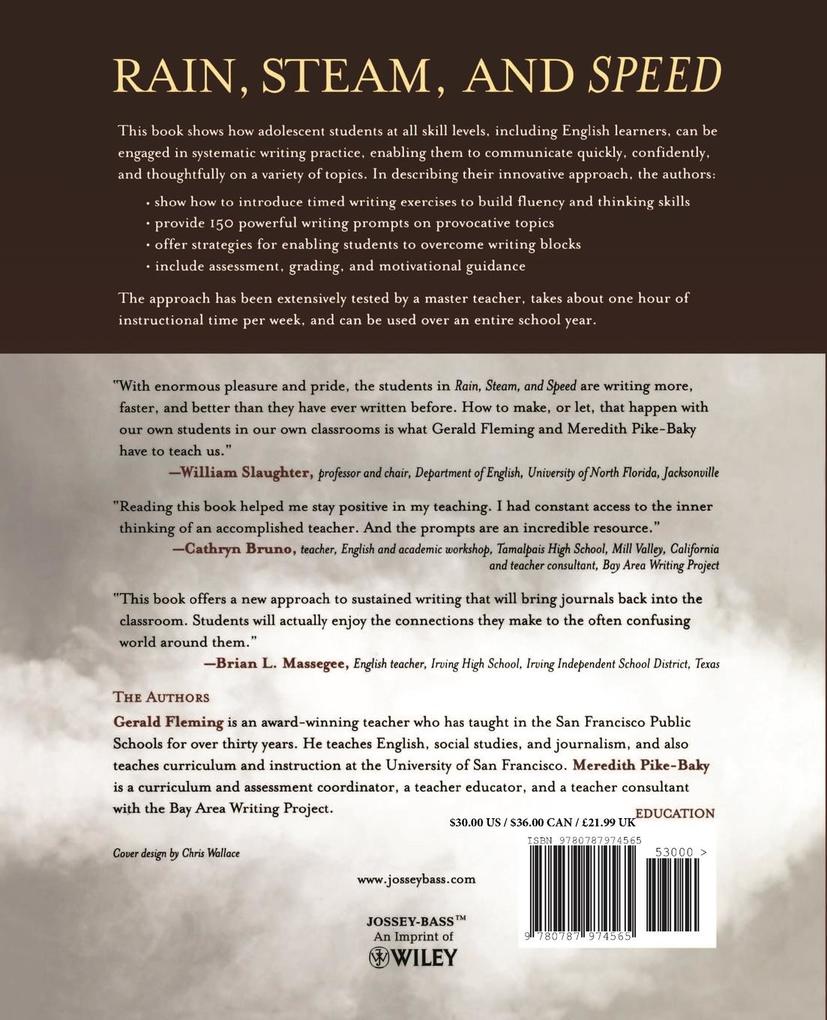
Zustellung: Sa, 19.07. - Do, 24.07.
Versand in 2 Wochen
VersandkostenfreiBestellen & in Filiale abholen:
This book shows how adolescent students at all skill levels, including English learners, can be engaged in systematic writing practice, enabling them to communicate quickly, confidently, and thoughtfully on a variety of topics. In describing their innovative approach, the authors: Show how to introduce timed writing exercises to build fluency and thinking skills Provide 150 powerful writing prompts on provocative topics Offer strategies for enabling students to overcome writing blocks Include assessment, grading, and motivational guidance The approach has been extensively tested by a master teacher, takes about one hour of instructional time per week, and can be used over an entire school year.
Inhaltsverzeichnis
Preface. Acknowledgments.
About the Authors.
Introduction.
ONE: Moving Journals Beyond the Banal.
An Admission: Early Errors.
What Changed?
Fluency Journals as Practice.
Inspiration for the Name.
TWO: Fluency: The Missing Ingredient in Writing Instruction.
What Is Writing Fluency?
Why Teach Fluency?
Supporting English Language Learners.
Correctness: Where Does It Fit in a Fluency Program?
The Importance of Prompts.
Music Promotes Fluency.
Journals and Gender.
PART ONE: Rain: Creating the Climate For Spontaneous Writing.
THREE: Introducing the Program to Students.
The Nitty-Gritty:Materials You'll Need.
Setting Up for Success: Self-Fulfilling Prophecies.
Laying the Track: The First Days.
Choosing the Distributor of Journals: End of Day One.
Clarifying the Classroom Protocol (Day Two).
Addressing Privacy and Child Abuse Issues.
Explaining the Grading Criteria.
Introducing the Music Component.
Reviewing the Protocol.
Presenting the First Prompt.
FOUR: The Essential Role of Music.
Necessary Equipment.
Selection and Progression of Music.
Letting Students Know What's Playing.
PART TWO: Steam: Prompts for Inspiration.
FIVE: Focusing on Topics That Matter.
Fluency Journals as "Safe Havens".
Choosing a Prompt.
Crafting Prompts of Your Own.
SIX: Working with the Prompts in the Classroom.
Reinforcing the Prompts Before the Writing Begins.
Addressing Student Questions.
Students'Own Prompts.
Choosing Skilled Prompt Readers.
PART THREE: Speed: The Writing Practice.
SEVEN: Motivation and Feedback.
Encouragement During Early Sessions.
The Teacher's Role During Journal Time.
Reinforcing the Energy.
Immediate Feedback.
The Power of Volunteer Readers.
How to Listen and What to Say.
EIGHT: Addressing Problems During Journal Time.
Disturbances.
Frozen Writers Counseling.
NINE: Assessment, Response, and Grading.
How to Read the Journals.
Commenting on the Written Entries.
The Inside Front Cover: The Grade and the Teacher's Writing.
More on the Carrot and Stick.
Writing Summative Comments.
Subsequent Grading.
Grading for Special Situations.
Alternative Evaluation Practices.
TEN: Extending the Work.
Ways to Share Journals.
Exploring Other Content Areas.
Possible Modifications to the Program.
EPILOGUE: Au Revoir, Journals!
PART FOUR: The Prompts.
Prompt Topics.
First Day.
Relationships.
Sorting Out the World.
Goofy and Imaginative.
The Natural World.
Taking Risks; Aspirations.
Inventions, Innovations, and Pastimes.
Personal Habits and Self-Identification.
Dreams.
Deep Life Issues.
Last Day.
APPENDIXES.
A. Selected and Annotated Discography.
B. Fifty Tips for Success from Students.
C. Taxonomy of Teacher Comments on Individual Entries.
D. Student Examples.
1. Pamela's End-of-Year Entry.
2. Ya Ni's End-of-Year Entry.
3. Tim's Advice.
4. Angela's Journal Strategies.
5. Jerry Xie's Pre and Post Entries.
E. Bibliography.
Index.
About the Authors.
Introduction.
ONE: Moving Journals Beyond the Banal.
An Admission: Early Errors.
What Changed?
Fluency Journals as Practice.
Inspiration for the Name.
TWO: Fluency: The Missing Ingredient in Writing Instruction.
What Is Writing Fluency?
Why Teach Fluency?
Supporting English Language Learners.
Correctness: Where Does It Fit in a Fluency Program?
The Importance of Prompts.
Music Promotes Fluency.
Journals and Gender.
PART ONE: Rain: Creating the Climate For Spontaneous Writing.
THREE: Introducing the Program to Students.
The Nitty-Gritty:Materials You'll Need.
Setting Up for Success: Self-Fulfilling Prophecies.
Laying the Track: The First Days.
Choosing the Distributor of Journals: End of Day One.
Clarifying the Classroom Protocol (Day Two).
Addressing Privacy and Child Abuse Issues.
Explaining the Grading Criteria.
Introducing the Music Component.
Reviewing the Protocol.
Presenting the First Prompt.
FOUR: The Essential Role of Music.
Necessary Equipment.
Selection and Progression of Music.
Letting Students Know What's Playing.
PART TWO: Steam: Prompts for Inspiration.
FIVE: Focusing on Topics That Matter.
Fluency Journals as "Safe Havens".
Choosing a Prompt.
Crafting Prompts of Your Own.
SIX: Working with the Prompts in the Classroom.
Reinforcing the Prompts Before the Writing Begins.
Addressing Student Questions.
Students'Own Prompts.
Choosing Skilled Prompt Readers.
PART THREE: Speed: The Writing Practice.
SEVEN: Motivation and Feedback.
Encouragement During Early Sessions.
The Teacher's Role During Journal Time.
Reinforcing the Energy.
Immediate Feedback.
The Power of Volunteer Readers.
How to Listen and What to Say.
EIGHT: Addressing Problems During Journal Time.
Disturbances.
Frozen Writers Counseling.
NINE: Assessment, Response, and Grading.
How to Read the Journals.
Commenting on the Written Entries.
The Inside Front Cover: The Grade and the Teacher's Writing.
More on the Carrot and Stick.
Writing Summative Comments.
Subsequent Grading.
Grading for Special Situations.
Alternative Evaluation Practices.
TEN: Extending the Work.
Ways to Share Journals.
Exploring Other Content Areas.
Possible Modifications to the Program.
EPILOGUE: Au Revoir, Journals!
PART FOUR: The Prompts.
Prompt Topics.
First Day.
Relationships.
Sorting Out the World.
Goofy and Imaginative.
The Natural World.
Taking Risks; Aspirations.
Inventions, Innovations, and Pastimes.
Personal Habits and Self-Identification.
Dreams.
Deep Life Issues.
Last Day.
APPENDIXES.
A. Selected and Annotated Discography.
B. Fifty Tips for Success from Students.
C. Taxonomy of Teacher Comments on Individual Entries.
D. Student Examples.
1. Pamela's End-of-Year Entry.
2. Ya Ni's End-of-Year Entry.
3. Tim's Advice.
4. Angela's Journal Strategies.
5. Jerry Xie's Pre and Post Entries.
E. Bibliography.
Index.
Produktdetails
Erscheinungsdatum
28. Oktober 2004
Sprache
englisch
Seitenanzahl
219
Autor/Autorin
Gerald Fleming, Meredith Pike-Baky
Verlag/Hersteller
Produktart
kartoniert
Gewicht
456 g
Größe (L/B/H)
235/191/13 mm
ISBN
9780787974565
Bewertungen
0 Bewertungen
Es wurden noch keine Bewertungen abgegeben. Schreiben Sie die erste Bewertung zu "Rain, Steam, and Speed" und helfen Sie damit anderen bei der Kaufentscheidung.










